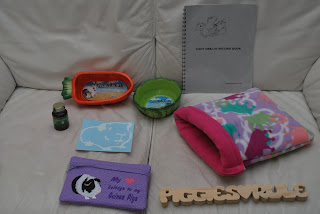Last weekend, our humans went to Orange County Cavy Haven's Pignic! What's a pignic? Well, its like a picnic, except with guinea pigs - except in this case, with many pigs, so it was essentially one big piggy party! Sadly, whee did not get to attend because our humans didn't want to put us through the long drive, but here are some of the pigtures they showed us.
Even though they were gone for less than 24 hours, our humans told us they really missed us. Many people brought their piggies and had them out in pens on the grass. In addition to showing several adoptable pigs, there were free piggy health checks, nail trimmings, and boar cleansing. They were also selling guinea pig toys and supplies.
This sounded like the most delicious part - a veggie eating contest! All the piggies and their humans sat in a circle to see who could eat their lettuce the fastest. If whee had a veggie eating contest, we would place our bet on Peaches to be the fastest eater.
 |
| Ready, set... |
 |
| ...MUNCH! |
 |
| Nom nom nom |
 |
| First place veggie eating winner |
OCCH also held a raffle, where all proceeds go to help their rescue pigs (like Revy). Our humans favorites were the piggy products, which included things from cloth huts to a large basket of Oxbow treats.
 |
| Cute shirt, the piggy on the front sort of looks like Peaches! |
 |
| Picking raffle tickets from the pigloo |
 |
| Very cute drawing |
Our humans also got to listen to some very informative talks. Nikki from OCCH talked about piggy diet and nutrition. Dr. Tom Greek gave an overview of basic cavy health and described some common illnesses.
In between all these activities, our humans walked around visiting with the other piggies. It was pretty warm out, so many of the pigs were resting in the shade, hiding under pigloos or blankets, and sitting next to cold water bottles. Our humans told us they found Morry's lookalike!
 |
| "Being cute is so tiring, it makes me sleepy!" |
 |
| Morry's cousin! |
 |
| A very Morry-like expression |
 |
| "Do you have a treat for me?" |
 |
| Napping in the stroller |
To our displeasure, there was also a cavy costume contest. Whee sort of wish they hadn't seen that, because now our girl wants to dress us up in costumes and outfits! The horror! *scampers away to hide in pigloo
 |
| Our favorite, Gin Gin the diva queen |
 |
| Ballerina peeg looks a lot like our Sharky |
 |
| Trojan Bunny hides treats instead of Trojans |
 |
| Abyssinian Bumblebee |
 |
| King of Peegs |
 |
| So many costumes for us to hide from |
Whee may not have gotten to go to Pignic, but at least our humans brought us back some presents. They got us a GuineaLynx
Cavy Health Record Book, two veggie shaped food bowls, a cushioned cozy, a guinea pig decal, a "Piggies Rule" wooden block, a small bottle of Health Force Nutritional's Green Mush probiotic, and a handmade piggy wallet purse - although whee think the last one was more for the girl than for us! Our favorite is the Gin Gin's Comfy Cozy. Apparently, you can even get them customized with your pigture and name on it!
 |
| Gin Gin's Comfy Cozies and her decorated diva cage |
 |
| Hmm, maybe our slaves will get us some! |
Well that was quite a long post. Whee are hungry, and will be going off to eat. Bye for now!



















































